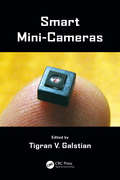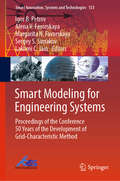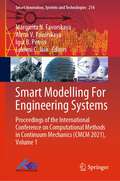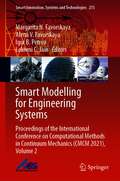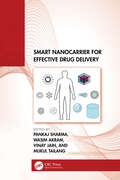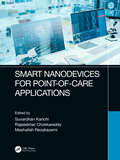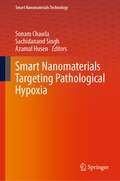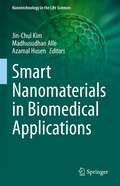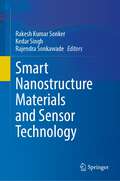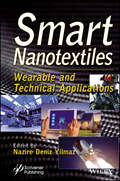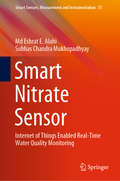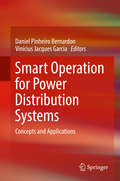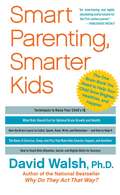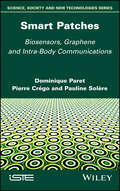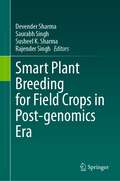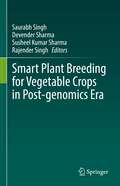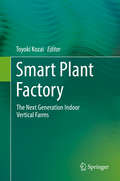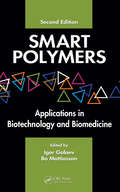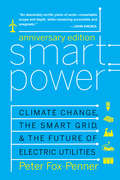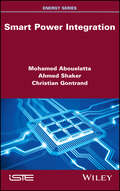- Table View
- List View
Smart Mini-Cameras
by Tigran V. GalstianAchieve the Best Camera Design: Up-to-Date Information on MCMsMiniature camera modules (MCMs), such as webcams, have rapidly become ubiquitous in our day-to-day devices, from mobile phones to interactive TV systems. MCMs-or "smart" cameras-can zoom, adjust their frame rate automatically with illumination change, focus at different distances, compen
Smart Modeling for Engineering Systems: Proceedings Of The Conference 50 Years Of The Development Of Grid-characteristic Method (Smart Innovation, Systems and Technologies #133)
by Lakhmi C. Jain Margarita N. Favorskaya Alena V. Favorskaya Igor B. Petrov Sergey S. SimakovThis book highlights the work of several world-class researchers on smart modeling of complex systems. The contributions are grouped into the four main categories listed below. · Numerical schemes construction for the solution of partial differential equations. · Numerical methods in continuum media mechanics problems. · Mathematical modeling in aerodynamics, plasma physics, deformable body mechanics, and geological hydrocarbon exploration. · Mathematical modeling in medical applications. The book offers a valuable resource for theoreticians and application scientists and engineers, as well as postgraduate students, in the fields of computational methods, numerical experiments, parallel algorithms, deformable solid bodies, seismic stability, seismic prospecting, migration, elastic and acoustic wave investigation, gas dynamics, astrophysics, aerodynamics, fluid dynamics, turbulent flows, hypersonic flows, detonation waves, composite materials, fracture mechanics, melting of metals, mathematical economics, medicine, and biology.
Smart Modelling For Engineering Systems: Proceedings of the International Conference on Computational Methods in Continuum Mechanics (CMCM 2021), Volume 1 (Smart Innovation, Systems and Technologies #214)
by Lakhmi C. Jain Margarita N. Favorskaya Alena V. Favorskaya Igor B. PetrovThis book is a collection of research papers selected for presentation at the International Conference on Smart Computational Methods in Continuum Mechanics 2021, organized by Moscow Institute of Physics and Technology and the Institute for Computer Aided Design of Russian Academy of Sciences. The work is presented in two volumes. The primary objective of the book is to report the state-of-the-art on smart computational paradigms in continuum mechanics and explore the use of artificial intelligence paradigms such as neural nets, and machine learning for improving the performance of the designed engineering systems. The book includes up-to-date smart computational methods which are used to solve problems in continuum mechanics, engineering, seismic prospecting, non-destructive testing, and so on. The main features of the book are the research papers on the application of novel smart methods including neural nets and machine learning, computational algorithms, smart software systems, and high-performance computer systems for solving complex engineering problems. The case studies pertaining to the real-world applications in the above fields are included. The book presents a collection of best research papers in English language from some of the world leaders in the field of smart system modelling and design of engineering systems.
Smart Modelling for Engineering Systems: Proceedings of the International Conference on Computational Methods in Continuum Mechanics (CMCM 2021), Volume 2 (Smart Innovation, Systems and Technologies #215)
by Lakhmi C. Jain Margarita N. Favorskaya Alena V. Favorskaya Igor B. PetrovThis book is a collection of research papers selected for presentation at the International Conference on Smart Computational Methods in Continuum Mechanics 2021, organized by Moscow Institute of Physics and Technology and the Institute for Computer Aided Design of Russian Academy of Sciences. The work is presented in two volumes. The primary objective of the book is to report the state-of-the-art on smart computational paradigms in continuum mechanics and explore the use of artificial intelligence paradigms such as neural nets and machine learning for improving the performance of the designed engineering systems. The book includes up-to-date smart computational methods which are used to solve problems in continuum mechanics, engineering, seismic prospecting, non-destructive testing, and so on. The main features of the book are the research papers on the application of novel smart methods including neural nets and machine learning, computational algorithms, smart software systems, and high-performance computer systems for solving complex engineering problems. The case studies pertaining to the real-world applications in the above fields are included. The book presents a collection of best research papers in English language from some of the world leaders in the field of smart system modelling and design of engineering systems.
Smart Nanocarrier for Effective Drug Delivery
by Pankaj Sharma Wasim Akram Vinay Jain Mukul TailangIntroducing Smart Nanocarrier for Effective Drug Delivery—a pioneering guide that delves into the realm of nanotechnology and its revolutionary impact on drug delivery systems. This comprehensive volume offers a deep understanding of smart nanocarriers' principles, design, and applications, setting it apart as a cutting-edge resource in the field.Nanotechnology has transformed drug delivery, enhanced therapeutic outcomes, and minimized side effects. This book provides a concise yet thorough overview of this dynamic landscape, elucidating key concepts and methodologies. It covers foundational principles and explores advanced strategies for targeted drug delivery, personalized medicine, and combination therapy.KEY FEATURES In-depth exploration of various types of nanocarriers, from liposomes to polymeric nanoparticles, highlighting their unique attributes. Detailed examination of smart stimuli-responsive nanocarriers that release drugs at precise locations and times. Comprehensive analysis of the latest advancements in nanomedicine, including nanodiagnostics and theranostics. Case studies illustrating real-world applications and success stories of nanocarrier-enhanced drug delivery. Smart Nanocarrier for Effective Drug Delivery is an invaluable resource for researchers, practitioners, and students in pharmaceutical sciences, nanotechnology, and drug delivery. It offers a roadmap to harnessing the potential of nanocarriers for enhancing therapeutic efficacy while minimizing adverse effects. This book equips readers with the knowledge to navigate the rapidly evolving landscape of smart nanocarrier technology, making it an essential addition to their professional toolkit.
Smart Nanodevices for Point-of-Care Applications
by Suvardhan Kanchi, Rajasekhar Chokkareddy and Mashallah RezakazemiSmart Nanodevices for Point-of-Care Applications examines the latest trends on the capabilities of nanomaterials for point-of-care (PoC) diagnostics and explains how these materials can help to strengthen, miniaturize, and improve the quality of diagnostic devices. A thorough explanation of all-in-one nanosmart devices is included, incorporating all of the applications and fundamentals of these smart devices. This book provides practical information on the following: novel and effective smart materials, better-quality health management, effective management of a disease, potential point-of-care devices, and mobile nanosensors. Additional Features Includes in-depth research based collation of the latest trends of smart devices Provides practical information on all-in-one nanosmart devices Explains how nanomaterials can help to strengthen and improve the quality of diagnostic devices Emphasizes the development of smart nanodevices, especially the miniaturization aspect
Smart Nanomaterials Targeting Pathological Hypoxia (Smart Nanomaterials Technology)
by Azamal Husen Sachidanand Singh Sonam ChawlaThe book showcases the newest research on smart nanoplatforms responding to “hypoxia”; an omnipresent pathological feature of many modern-day diseases and its potential applications. The book demonstrates the versatility of hypoxia targeted smart nanoplatforms in disease management in diverse pathological settings presented in chapters contributed by various experts in the field. The themes in the book touch upon critical facets to address pathological hypoxia such as nanomaterials enhancing oxygenation, hypoxia responsive nanoformulations which deliver the drug directly to the hypoxic site, limited toxicity and enhanced efficacy of smart nanoformulations to counter molecular consequences of hypoxia, and theranostics combining hypoxia detection systems with drug delivery systems. This book disseminates the current implications of smart nanomaterials in disease management that can be exploited by scholars, researchers, and pharma industries to develop, manufacture, and commercialize hypoxia targeted diagnostics and therapeutics.
Smart Nanomaterials in Biomedical Applications (Nanotechnology in the Life Sciences)
by Azamal Husen Jin-Chul Kim Madhusudhan AlleWith the start of 2020, the wrath of pandemic challenged the scientific community to develop more advanced drug delivery approaches for biomedical applications, endowing conventional drugs with additional therapeutic benefits and minimum side effects. Although significant advancements have been done in the field of drug delivery, there is a need to focus towards strategizing novel and improved drug delivery systems that should be convenient and cost-effective to the patients, and simultaneously they should also provide financial benefits to pharmaceutical companies. Controlled drug delivery technology offers ample opportunities and scope for improvising the therapeutic efficacy of drugs via optimizing the drug release rate and time. For this endeavour, smart nanomaterials have served as remarkable candidates for biomedical applications, owing to their ground-breaking properties and design. The development of such nanomaterials requires a broad knowledge related to their physio-chemical properties, molecular structure, mechanisms by which the nanomaterials interact with the cells, and methods by which drugs are released at the site of action. This knowledge must also be allied with the knowledge of signaling crosstalk mechanisms that are modulated by the nanomaterial-drugs composite. It can be anticipated that these emerging drug delivery technologies can facilitate the world to successfully encounter such pandemic outbursts in the future in a cost-effective and time-effective manner. The chapters in this book deal with the advanced technologies and approaches that can benefit advanced students, researchers, and industry experts in developing smart and intelligent nanomaterials for future biomedical applications, and development, manufacturing, and commercialization for controlled and targeted drug delivery.
Smart Nanosensors (Smart Nanomaterials Technology)
by Imran UddinThis book serves as a comprehensive compilation of contemporary research conducted in the domain of nanosensors. The amalgamation of many elements within the emerging field contributes to the development of a useful collection specifically designed for inexperienced researchers in the domain of smart materials and nanosensor technologies. An adequate range of subjects has been incorporated into the present book. It includes enzyme-mimetic use of smart nanomaterials for enhanced biosensing applications, theranostic utilization of smart nanomaterials for targeted drug delivery, sensors for pollutant detection, and the utilization of smart nanomaterials in the development of biosensors for studying host-microbe interactions. Nanosensors have emerged as a promising avenue for various applications, including sensing in the fields of medicine, packaging, and heavy metal ion detection. Recent developments in the field of smart nanomaterials have led to significant advancements in the application of intelligent switches and sensors within the domains of agriculture, food production, and water treatment. The primary emphasis of this book is the study of the synthesis and fabrication processes involved in the production of smart materials, together with their application within the domain of sensor technology. The existing body of literature has two main categories: introductory textbooks that provide fundamental knowledge about the field and specialized publications that focus exclusively on certain subtopics within the domain of sensor technology. The existing material of the book makes it a complete reference resource that is well-suited for researchers in the area. It especially caters to advanced graduate students who are seeking senior graduate, MTech, and MS degrees in the subject of sensor technology. Additionally, this publication would function as an essential resource for researchers across diverse disciplines within the area of materials science who are aiming to propel the development of smart materials.
Smart Nanostructure Materials and Sensor Technology
by Rakesh Kumar Sonker Kedar Singh Rajendra SonkawadeThis book highlights the significance and usefulness of nanomaterials for the development of sensing devices and their real-life applications. The book also addresses various means of synthesizing 2D/3D nanomaterials, e.g., hydrothermal deposition process, electrospinning, Ostwald ripening, sputtering heterogeneous deposition, liquid-phase preparation, the vapor deposition approach, and aerosol flame synthesis. It presents an informative overview of the role of nanoscale materials in the development of advanced sensor devices at nanoscale and discusses the applications of nanomaterials in different forms prepared by diverse techniques in the field of optoelectronics and biomedical devices. Major features, such as type of nanomaterials, fabrication methods, applications, tasks, benefits and restrictions, and saleable features, are also covered.
Smart Nanotextiles: Wearable and Technical Applications
by Nazire Deniz YilmazSmart Nanotextiles Wearable and Technical Applications This groundbreaking book comprehensively reviews the utilization of smart nanotextiles in various application areas by referring to requirements specific to various application fields, sharing the findings of some of the latest research efforts and state-of-art smart nanotextiles technologies, as well as providing insights relating to challenges and opportunities facing current and future smart nanotextiles. This book covers the emerging and exciting field of nanotextiles and their many applications. Smart nanotextiles form a novel group of materials that are utilized/can be utilized in an array of application areas, such as biomedicine (health monitoring, controlled drug release; wound care, and regenerative medicine), communication, sports, fashion, energy harvesting, protection, filtration, civil and geotechnical engineering, transportation, and so on, including wearable and technical fields. Whereas textiles provide a convenient platform for smart functionality, nanotechnology assures that the favorable characteristics of the textile structure are not impaired by the smart functioning components. Furthermore, based on the superior characteristics of nanostructured components in comparison to macromaterials and micromaterials, nanomaterials provide augmented smart functionality. However, despite the immense research efforts that have been devoted to smart nanotextiles, most of them have not yet transcended the commercialization stage due to high cost, difficulty in large-scale production, low reliability, and potential detrimental effects of nanomaterials on human health and the environment. The 12 chapters comprising this book are all written by subject-matter experts from around the world and discuss the next-generation products along with their challenges and opportunities. Audience Researchers, technologists, industrial engineers, and postgraduate students in the fields of textiles, intelligent materials, electronics, sensors, actuators, biomedicine, fashion, filtration, transportation, civil engineering, environmental engineering, communication, sports performance, and materials science, who have an interest in smart materials, nanotechnology and wearables.
Smart Nitrate Sensor: Internet of Things Enabled Real-Time Water Quality Monitoring (Smart Sensors, Measurement and Instrumentation #35)
by Subhas Chandra Mukhopadhyay Md Eshrat AlahiThis book presents the design and development of an Internet of Things (IoT) enabled, smart sensor to detect nitrate contamination in natural water. It considers three different sensors designed, fabricated and configured for nitrate detection: a Graphite/PDMS and Si-based MEMS sensors, and aFR4-based sensor. It also introduces a selective polymer material developed by means of the ion imprinting polymerization technique that was used as a coating on the Si-based MEMS sensor. Further, the book discusses the development of a smart sensing system that can be used to remotely monitor the nitrate concentration in any water. Fully explaining all the techniques used, the book is of interest to engineers, researchers and scientists working in the field of the water-quality measurement.
Smart Operation for Power Distribution Systems: Concepts and Applications
by Daniel Pinheiro Bernardon Vinícius Jacques GarciaThis book discusses the operation of electrical distribution systems, presenting contemporary concepts and applications with a focus on integration for smart operation and grids. The authors address the main concepts and techniques of active management of smart electrical distribution system operation, including state estimation, self healing, volt-var control, protection systems, operations planning, and commercial and emergency dispatch. From each topic, an overview of concepts are given together with examples related to the management of these systems, thus providing a valuable resource for the design, implementation and management of efficient and truly sustainable smart systems.
Smart Parenting, Smarter Kids
by Dr David WalshEvery week new discoveries about the brain make the news, often promising parents the latest "right" way to nurture their kids' developing brains and behavior. And every day there's a new technology that demands your child's attention, a new game or toy that purports to make your kid smarter, and a new snack promising to be healthy as well as tasty. How's a busy parent to make heads or tails of all these claims? You turn to Dr. David Walsh, an expert at translating the headline-making, cutting-edge findings into practical suggestions for parenting today. In his previous bestseller, Why Do They Act That Way?, Walsh showed how to manage the difficult teenage years by understanding how the adolescent brain develops. Now he's written a complete guide to parenting from birth through the teen years, with recommendations that will help maximize any child's potential. Smart Parenting, Smarter Kids doesn't just describe new research findings or explain interesting brain facts. It equips parents with usable information across a range of topics, like exercise, nutrition, play, sleep, stress, self-discipline, emotional intelligence, and connection. Some discoveries in neuroscience confirm age-old parental wisdom while others may prompt you to make immediate changes. Still other brain discoveries help explain behaviors that have puzzled parents forever, like why friendly, easygoing kids can become withdrawn and sullen dragons overnight when they enter adolescence, or why girls and boys tend to have such different classroom experiences. Filled with helpful quizzes and checklists for easy reference, Smart Parenting, Smarter Kids gives specific advice about how to make the best daycare, preschool, and schooling decisions for your kids; for example, how to deal with stressful events as a family, and how to manage your child's internet and media use. And all these findings across different fields of research work together in reaching the same goal: When children are guided to eat, sleep, play, exercise, learn, and connect with others in healthy ways, their minds blossom and they are able to reach their full potential--academically, socially, physically, and emotionally. These real-life applications in Dr. Walsh's new book put science into practice with a personal plan that explains how (and why) you can parent with the brain in mind.
Smart Parenting, Smarter Kids: The One Brain Book You Need to Help Your Child Grow Brighter, Healthier, and Happier
by David WalshEvery week new discoveries about the brain make the news, often promising parents the latest "right" way to nurture their kids' developing brains and behavior. And every day there's a new technology that demands your child's attention, a new game or toy that purports to make your kid smarter, and a new snack promising to be healthy as well as tasty. How's a busy parent to make heads or tails of all these claims? You turn to Dr. David Walsh, an expert at translating the headline-making, cutting-edge findings into practical suggestions for parenting today. In his previous bestseller, Why Do They Act That Way?, Walsh showed how to manage the difficult teenage years by understanding how the adolescent brain develops. Now he's written a complete guide to parenting from birth through the teen years, with recommendations that will help maximize any child's potential. Smart Parenting, Smarter Kids doesn't just describe new research findings or explain interesting brain facts. It equips parents with usable information across a range of topics, like exercise, nutrition, play, sleep, stress, self-discipline, emotional intelligence, and connection. Some discoveries in neuroscience confirm age-old parental wisdom while others may prompt you to make immediate changes. Still other brain discoveries help explain behaviors that have puzzled parents forever, like why friendly, easygoing kids can become withdrawn and sullen dragons overnight when they enter adolescence, or why girls and boys tend to have such different classroom experiences. Filled with helpful quizzes and checklists for easy reference, Smart Parenting, Smarter Kids gives specific advice about how to make the best daycare, preschool, and schooling decisions for your kids; for example, how to deal with stressful events as a family, and how to manage your child's internet and media use. And all these findings across different fields of research work together in reaching the same goal: When children are guided to eat, sleep, play, exercise, learn, and connect with others in healthy ways, their minds blossom and they are able to reach their full potential--academically, socially, physically, and emotionally. These real-life applications in Dr. Walsh's new book put science into practice with a personal plan that explains how (and why) you can parent with the brain in mind.
Smart Patches: Biosensors, Graphene, and Intra-Body Communications
by Dominique Paret Pierre Crego Pauline SolereThis book defines and elucidates the topic of smart "second skin" clothing, which must be flexible, washable, ironable, long-lasting and battery-free. We explore the possibilities for its use in fields such as health, well-being, sports and leisure. Smart Patches presents techniques that can be used within the limits established by regulations (EMC, normative, GDPR, ANSES, etc.) to help make smart clothing a marketable product at an affordable price. This book studies the creation and performance of various sensors and biosensors based on graphene materials and describes the functioning of Intra-Body Communications (IBC), as well as all the internal and external parameters involved in this type of technology. The performances and limits of these IBC and technologies are presented, together with concrete application examples.
Smart Plant Breeding for Field Crops in Post-genomics Era
by Rajender Singh Saurabh Singh Devender Sharma Susheel K. SharmaThis book emphasizes on cutting-edge next-generation smart plant breeding approaches for maximizing the use of genomic resources generated by high-throughput genomics in the post-genomic era. Through this book the readers would learn about the recent development in the genomic approaches such as genotype by sequencing (GBS) for genomic analysis (SNPs, Single Nucleotide Polymorphism), whole-genome re-sequencing (WGRS) and RNAseq for transcriptomic analysis (DEGs, Differentially Expressed Genes). To maximize the genetic gains in the cereal/food crops, the book covers topics on transgenic breeding, genome editing, high-throughput phenotyping, reliable/precision phenotyping and genomic information-based analysis. In the era of climate change and the ever-increasing population, food security and nutritional security are the primary concern of plant breeders, growers, and policymakers to address the UN’s sustainable development goals. Chapters of this book cohere around these goals and covers techniques such as (QTL mapping, association studies, candidate gene identification), omics, RNAi [through micro RNA (miRNA), small interfering RNA (siRNA) and artificial micro RNA (amiRNA)]. It also covers other genomic techniques like antisense technology, genome editing (CRISPR/cas9, base editing) and epigenomics that assist the crop improvement programmes to fulfil the UNs sustainable development goals. It explores the influence of rapidly available sequencing data assisting in the next generation breeding programmes. This volume is a productive resource for the students, researchers, scientists, teachers, public and private sector stakeholders involved in the genetic enhancement of cereal crops.
Smart Plant Breeding for Vegetable Crops in Post-genomics Era
by Rajender Singh Saurabh Singh Devender Sharma Susheel Kumar SharmaThis book dispenses a comprehensive coverage of up-to-date account of genomics and genome editing enriched smart plant breeding approaches for enhancing genetic gains in vegetable crops in the post-genomics era. The main focus of the present volume is to illuminate the applications of new techniques evolved in the post-genomics era. The techniques covered are high-throughput sequencing of DNA and RNA, genome editing, epigenetics and epigenomics, genotype by sequencing (GBS), QTL-seq and RNA-seq for transcriptome analysis. Vegetables are the important component of healthy diet, source of energy and hold a promising position in building up a strong immunity. Zero hunger and attaining the food and nutritional security is the top priority of United Nations development goals. Smart breeding of food and vegetable crops to fight the challenges ahead in sustainable manner by keeping the harmony with nature is an important approach to fulfill the United Nations Sustainable Development Goals (UN-SDGs). This edited book highlights the modern results in smart vegetable breeding in the post genomics era and forecasts crucial areas of future needs. It is an important reference for the, readers, students, researchers, scientists in academia and research industries to provide them comprehensive information of innovative approaches for crop improvement in the post-genomics era and in the era of and climate change. Even the readers, academia, social activists, and others fond of reading will get a fair idea of journey travelled so far and future roadmap for fighting the challenges ahead to meet the sustainable development goals.
Smart Plant Factory: The Next Generation Indoor Vertical Farms
by Toyoki KozaiThis book describes the concept, characteristics, methodology, design, management, business, recent advances and future technologies of plant factories with artificial lighting (PFAL) and indoor vertical farms. The third wave of PFAL business started in around 2010 in Japan and Taiwan, and in USA and Europe it began in about 2013 after the rapid advances in LED technology. The book discusses the basic and advanced developments in recent PFALs and future smart PFALs that emerged in 2016. There is an emerging interest around the globe in smart PFAL R&D and business, which are expected to play an important role in urban agriculture in the coming decades. It is also expected that they will contribute to solving the trilemma of food, environment and natural resources with increasing urban populations and decreasing agricultural populations and arable land area. Current obstacles to successful PFAL R&D and business are: 1) no well-accepted concepts and methodology for PFAL design and management, 2) lack of understanding of the environmental effects on plant growth and development and hydroponics among engineers; 3) lack of understanding of the technical and engineering aspects of PFAL among horticulturists; 4) lack of knowledge of the technical challenges and opportunities in future PFAL businesses among business professionals, policy makers, and investors and 5) lack of a suitable textbook on the recent advances in PFAL technologies and business for graduate students and young researchers. This book covers all the aspects of successful smart PFAL R & D and business.
Smart Polymers: Applications in Biotechnology and Biomedicine, Second Edition
by Bo Mattiasson Igor GalaevThe first book to tackle the application of smart polymers in bioseparation and bioprocessing, Smart Polymers: Applications in Biotechnology and Biomedicine broke new ground in this challenging field. Completely revised, updated, and following in the footsteps of its predecessor, the second edition is poised to take its place as a premier reference
Smart Polymers: Basics and Applications
by Asit Baran SamuiSmart materials have been produced by conceiving of the idea of materials/systems having a fourth dimension. To match advances in instrumentation, efforts are being made to develop materials, resulting in smart materials with enhanced performance. In nature, the action of stimuli-responsive materials is reversible; this idea has attracted interest for its potential research and industrial applications. The challenge remains how to couple these applications with environmental consciousness.This book presents the basics of smart polymers and describes their current and future applications. This book is different from other books on the subject in that it explores polymer materials’ smart behavior in more depth, covering vibration damping, thermal and electrochemical energy, sensing at trace level, biotechnology, and so on. The 14 chapters in this book cover diverse areas, including:• Photoresponsive polymers that can be manipulated using a specific frequency of light• Designing polymers for vibration damping• Smart manipulations of hydrophobic and super-hydrophobic polymers• Biopolymers, including hydrogels for smart application, drug delivery, and other uses• Smart paints• Self-healing and shape memory polymers• Holography for data storage• Phase change polymers and solid polymer electrolytes for thermal and electrochemical energy• Molecular imprinting polymers for sub-ppm sensing and removal of unwanted materials• Smart textiles, and the concept of advanced textilesThis book will be of particular interest to researchers, postgraduates, and industry experts. It offers an extensive introduction to the basics of smart polymers and their possible applications.
Smart Ports
by Yuan Liu Weijian MiThis book demonstrates the concept of ecological system of the smart ports. The innovation is emphasized as the essence of the ecological system as well as the prerequisite and foundation of sustainable development of smart ports. The main supporting technologies of smart ports, including cyber-physical system, middle-office system, blockchain, artificial intelligence, machine vision, AR/VR, system simulation and emulation, digital monitoring and diagnosis, etc., are introduced with concepts and development descriptions as well as practical application cases. It could be used as demonstration and reference for the administrative staff, engineers and technicians as well as researchers in construction and operation of smart ports.
Smart Power Anniversary Edition: Climate Change, the Smart Grid, and the Future of Electric Utilities
by Peter Fox-Penner Daniel Dobbeni Dan Esty Lyon Rive James E. RogersFew industries in the U.S. are as stuck in the past as our utilities are. In the face of growing challenges from climate change and the need for energy security, a system and a business model that each took more than a century to evolve must now be extensively retooled in the span of a few decades. Despite the need, many of the technologies and institutions needed are still being designed or tested. It is like rebuilding our entire airplane fleet, along with our runways and air traffic control system, while the planes are all up in the air filled with passengers. In this accessible and insightful book, Peter Fox-Penner considers how utilities interact with customers and how the Smart Grid could revolutionize their relationship. Turning to the supply side, he considers the costs of, and tradeoffs between, large-scale power sources such as coal plants and small-scale power sources close to customers. Finally, he looks at how utilities can respond to all of these challenges and remain viable, while financing hundreds of billions of dollars of investment without much of an increase in sales. Upon publication, Smart Power was praised as an instant classic on the future of energy utilities. This Anniversary Edition includes up-to-date assessments of the industry by such leading energy experts as Daniel Estes and Jim Rogers, as well as a new afterword from the author. Anyone who is interested in our energy future will appreciate the clear explanations and the in-depth analysis it offers.
Smart Power Integration
by Christian Gontrand Ahmed Shaker Mohamed AbouelattaSmart power integration is at the crossroads of different fields of electronics such as high and low power, engine control and electrothermal studies of devices and circuits. These circuits are complex and are heavily influenced by substrate coupling, especially where 3D integration is concerned. This book provides an overview of smart power integration, including high voltage devices, dedicated and compatible processes, as well as isolation techniques.Two types of integration are highlighted: modular or hybrid integration, together with compatible devices such as the insulated gate bipolar transistor (IGBT); and monolithic integration, specifically through the paradigm of functional integration. Smart Power Integration outlines the main MOS devices for high voltage integrated circuits, and explores into the fields of codesign, coupling hardware and software design, including applications to motor control. Studies focusing on heat pipes for electronics cooling are also outlined.
Smart Power: Climate Change, The Smart Grid, And The Future Of Electric Utilities
by Peter Fox-PennerA new national policy on climate change is under debate in the United States and is likely to result in a cap on greenhouse gas emissions for utilities. This and other developments will prompt utilities to undergo the largest changes in their history. Smart Power examines the many facets of this unprecedented transformation. This enlightening book begins with a look back on the deregulatory efforts of the 1990s and their gradual replacement by concerns over climate change, promoting new technologies, and developing stable prices and supplies. In thorough but non-technical terms it explains the revolutionary changes that the Smart Grid is bringing to utility operations. It also examines the options for low-carbon emissions along with the real-world challenges the industry and its regulators must face as the industry retools and finances its new sources and systems. Throughout the book, Peter Fox-Penner provides insights into the policy choices and regulatory reform needed to face these challenges. He not only weighs the costs and benefits of every option, but presents interviews with informed experts, including economists, utility CEOs, and engineers. He gives a brief history of the development of the current utility business model and examines possible new business models that are focused on energy efficiency. Smart Power explains every aspect of the coming energy revolution for utilities in lively prose that will captivate even the most techno-phobic readers.
